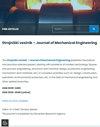煤基锅炉过热器管临界失效分析
IF 1.2
4区 工程技术
Q3 ENGINEERING, MECHANICAL
Strojniski Vestnik-Journal of Mechanical Engineering
Pub Date : 2017-05-08
DOI:10.5545/SV-JME.2016.4188
引用次数: 28
摘要
本文介绍了一种煤基锅炉T-22材料过热器管失效研究方法。该过程包括目视观察、取样位置的确定、基体合金的总体化学成分的测定、使用光学显微镜进行显微组织研究、使用扫描电子显微镜(SEM)探索更精细的结构细节、对从不同位置获得的样品进行硬度评估、对不同失效位置进行断口分析。用x射线衍射(XRD)研究了腐蚀产物粘附在内表面,并确定了失效的性质。在四个月的时间里,接连发生了三起过热器管故障。观察到这些试管发生了明显的壁变薄。利用扫描电镜对失效区域和接收管上一定距离的区域进行了显微检查,以确定失效机制。内表面观察到分层氧化腐蚀(剥落)。除了主要裂纹外,在两个管的纵向上观察到许多近乎直线的裂纹。在服役开采过程中,晶界接近开裂/胀形、孔洞形成/去黏聚表现为蠕变变形。破坏机制是由于沿内壁过度氧化腐蚀导致厚度降低、合金碳化物球化、析出相粗化以及沿晶界形成蠕变空洞导致材料在厚鳞片覆盖区域附近流动导致晶间开裂。此外,合金体硬度急剧下降,最终出现“薄唇鱼口”骨折。本文章由计算机程序翻译,如有差异,请以英文原文为准。
Critical Failure Analysis of Superheater Tubes of Coal-Based Boiler
This paper highlights a methodology for failure investigation of superheater tubes made of the material T-22 of a coal-based boiler. The process includes visual observation, the identification of sampling locations, the determination of the bulk chemical composition of the base alloy, microstructural investigation using optical microscopy, the exploration of finer structural details using a scanning electron microscope (SEM), the evaluation of hardness over samples obtained from different locations, the fractographic analysis of different failed locations, the X-ray diffraction (XRD) study of corrosion products adhered to inner surfaces, and the determination of the nature of the failure. Within a span of four months, three successive failures of superheater tubes were reported. The tubes were observed to have undergone significant wall thinning. Microscopic examinations using SEM on the failed region and a region some distance away on the as-received tubes were conducted in order to determine the failure mechanism. Layer-wise oxidation corrosion (exfoliation) in the inner surface was observed. Apart from major cracking, a number of nearly straight line crackings were observed in the longitudinal direction of both tubes. Close to cracking/bulging, void formation/de-cohesion of grain boundary indicated creep deformation under service exploitation. The failure mechanism was identified to be a result of excessive oxidation corrosion along the inside wall to reduce thickness, the spheroidization of alloy carbides and the coarsening of precipitate as well as creep void formation along grain boundary leading to inter-granular cracking with material flow near regions covered with thick scales. Moreover, there was a drastic reduction in bulk hardness of alloy and finally ‘thin lip fish mouth’ fractures.
求助全文
通过发布文献求助,成功后即可免费获取论文全文。
去求助
来源期刊
CiteScore
3.00
自引率
17.60%
发文量
56
审稿时长
4.1 months
期刊介绍:
The international journal publishes original and (mini)review articles covering the concepts of materials science, mechanics, kinematics, thermodynamics, energy and environment, mechatronics and robotics, fluid mechanics, tribology, cybernetics, industrial engineering and structural analysis.
The journal follows new trends and progress proven practice in the mechanical engineering and also in the closely related sciences as are electrical, civil and process engineering, medicine, microbiology, ecology, agriculture, transport systems, aviation, and others, thus creating a unique forum for interdisciplinary or multidisciplinary dialogue.

 求助内容:
求助内容: 应助结果提醒方式:
应助结果提醒方式:


